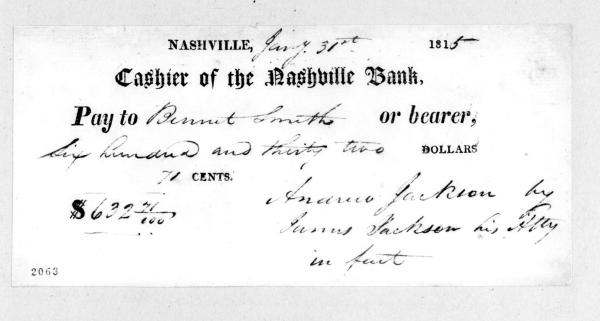In the vast tapestry of history, the humble bank check stands as a testament to the evolution of financial transactions. Journey back to the early 19th century, a time when the ink quill danced upon parchment, and transactions were sealed with the elegant flourish of a signature. Imagine the scene: it's January 31, 1815, and Andrew Jackson, a figure of great prominence in American history, sits at his desk. With purposeful strokes, he fills out a check from the Nashville Bank to Bennett Smith, an individual whose story is lost to the annals of time.
The check, a document both simple and profound, bears witness to the rudimentary elements of financial exchange. At its core, it echoes the components we recognize today, albeit with a charming antiquity. The payee line, akin to its modern counterpart, designates the recipient of the funds. In this case, Bennett Smith's name is delicately inscribed, an acknowledgment of debt and trust.
Moving to the dollar box, a numerical representation of the transaction's value, we encounter a familiar sight. Yet, the figures themselves possess a gravity, a weightiness that seems to transcend mere currency. Here, $632.71 stands as a testament to wealth, a sum significant enough to warrant documentation in an era where every penny held immense value.
But perhaps the most captivating aspect of this relic from the past lies in the amount expressed in words. In a flourish of language, the check declares its intent: "Six Hundred and Thirty-Two Dollars and Seventy-One Cents." It's a linguistic dance, a poetic rendering of value that contrasts sharply with the sterile precision of modern numerical notation.
As we delve further, we encounter the memo section, an invitation for personalization and sentimentality. Here, Andrew Jackson might have penned a fleeting note—a gesture of goodwill, a reminder of the transaction's purpose, or a reflection of his own thoughts in that fleeting moment.
The date, January 31, 1815, serves as a temporal anchor, tethering the check to a specific moment in history. It's a reminder that financial transactions, however mundane, are inexorably linked to the ebb and flow of human existence.
And finally, the signature—a flourish of ink that binds the document with legal and personal authority. Andrew Jackson's scrawl, a mark of his identity and responsibility, serves as a testament to the trust inherent in every exchange.
In comparing this artifact of the past to its modern-day counterpart, we glimpse the threads of continuity that bind us across centuries. Though the medium may have evolved, the essence remains unchanged—a promise of payment, a symbol of trust, and a record of human interaction woven into the fabric of time.
Check Writing Number (amount of money) to Words
